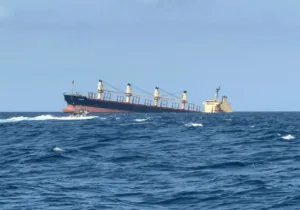With threats like terrorism and cyber-attacks dominating the headlines, it can be easy to lose sight of the importance of the U.S. Navy patrolling waters around the world. However, from historical, economic, and security perspectives a strong, globally positioned Navy remains crucial to American prosperity and leadership.
America’s History of Global Engagement
The U.S. has always been a maritime nation and a beneficiary of the global economy. The U.S. Navy has been deployed around the globe nearly since its outset. Indeed, the U.S. Navy was protecting trade and commerce as early as 1801 when U.S. leaders decided to take action against Barbary pirates who constantly kidnapped the crew of American ships and held them for ransom in the Mediterranean. As America’s economy rose to prominence, its reliance on freedom of navigation rose as well.
Protecting Economic Prosperity
Around 90 percent of the world’s goods are transported on the seas, and 99 percent of transoceanic data traffic is currently transmitted via submarine cables. Nearly all electronic financial transactions between the U.S. and other continents run through these cables, along with emails and phone calls. The cargo ships on the seas and the cables undersea are the backbones of today’s global economy.
As the U.S. has benefitted from these cost-effective means of transferring goods and services, vulnerability at sea has also grown. Much of the world’s oil and goods are shipped through two chokepoints: the Strait of Hormuz (bordered by Iran) and the Strait of Malacca (near China and connecting the Indian and Pacific Oceans). If a state actor were to blockade either strait—as Iran has threatened—there would be severe economic effects.
Emerging Security Challenges
While America has enjoyed naval supremacy since the end of the Cold War, new and old challengers have emerged with the potential to destabilize strategically significant regions of the world.
China has increasingly bullied its neighbors in the South and East China Seas, where major U.S. trading partners and treaty allies such as Japan, South Korea, and the Philippines have territorial disputes with China. As more than half the world’s seaborne trade traverses these waters, it is in America’s interest to maintain a robust naval presence there. U.S. Navy ships help deter conflict in the region and ensure that global commerce can continue to flow, benefiting America and everyone else.
In Europe, Russia has engaged in a series of provocative actions reminiscent of the Soviet Union. According to the Commander of NATO Maritime Command, there has recently been “more activity from Russian submarines than we’ve seen since the days of the Cold War.” Russia’s invasion of the Crimean Peninsula further secured its fleet’s access to the Black Sea and therefore also the Mediterranean Sea. Finally, Russia has embarked in a campaign to revitalize its military presence in the Arctic. The lack of robust NATO naval presence in the region has in part emboldened Putin to engage in this activity.
Closer to U.S. shores, lower intensity threats continue to pose challenges to regional stability. The narcotic trade increasingly uses the open seas to ship illicit drugs from South and Central America to the U.S. and Europe. Yet the U.S. in recent years has drawn down its naval forces in that region, meaning illegal goods will continue to be delivered, and the organized crime units that profit from them will continue to wield destabilizing influence throughout Latin America.
Undersized Fleet
In spite of these threats around the globe, the U.S. Navy continues to fall short of what is necessary to sustain operations that preserve peace around the globe. The Navy states that it requires 308 ships to fulfill its responsibilities, but analysis free of budgetary and political considerations has consistently yielded a requirement of around 350 ships. Yet the Navy cannot even reach the lower figure: the fleet currently stands at 272 vessels. This has resulted in ships going on longer deployments, which in turn causes deferred maintenance work and sailors spending more time at sea, away from their families. Eventually, deferred maintenance and stretched sailors will lead to broken ships and broken sailors.
Preserving Peace and Prosperity
We may take for granted the fact that we can email a friend in Europe with ease, or buy goods that were produced in Korea. But it is the U.S. Navy’s global presence that has fostered this era of global commerce. The U.S., as a beneficiary of the global economy, should continue to maintain robust naval forces, as they provide a great return on investment for stability, deter potential adversaries and aggressors, and reassure allies and partners who support the security of U.S. interests and economic freedom around the globe.
—
Brian Slattery is a Policy Analyst for National Security in the Center for National Defense at The Heritage Foundation. He supports all research efforts on defense policy and specifically focuses on U.S. Coast Guard issues and Arctic security policy. He also manages the production of the annual Index of U.S. Military Strength. Prior to joining Heritage, Slattery served as a Defense Research Assistant for Congressman J. Randy Forbes of the U.S. House of Representatives, where he supported the Congressman’s military affairs portfolio. Brian earned a Bachelor of Arts degree in International Affairs with a business concentration from Xavier University, while also earning a minor in Classical Humanities. He earned a Master of Public Policy degree with a focus in national security from the George Mason University School of Policy, Government, and International Affairs. He and his wife Elizabeth live in Silver Spring, MD.
Photo Credit: American and Japanese ships sail in formation following the conclusion of the Annual Ex (AE) 16 on November 20, 2015. AE16 is conducted to increase interoperability between Japanese and American forces through training in air and sea operations. (U.S. Navy photo by Mass Communication Specialist 2nd Class Daniel James Lewis/Released)






 Sponsor a student for Christianity & National Security 2024
Sponsor a student for Christianity & National Security 2024